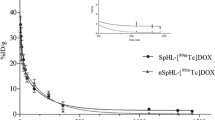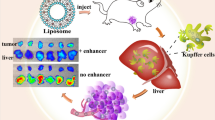Abstract
Purpose. To evaluate benefits in tumor localization, availability, and noncancerous organ distribution of doxorubicin (DOX) delivered via small (≤120 nm) sterically stabilized immunoliposomes targeted against a tumor-associated antigen in fibrosarcoma-bearing mice.
Methods. DOX-loaded liposomes were prepared with (i) specific monoclonal IgG3 antibody (32/2, D-SSIL-32/2); (ii) non-specific IgG3 (D-SSIL-IgG); or (iii) no IgG (D-SSL) on their surface. Equal DOX amounts were injected intravenously via each type of liposome into BALB/c mice carrying experimental lung metastases of a polyoma virus-induced fibrosarcoma (A9 etc 220) expressing a polyoma virus-induced tumor-associated antigen (PAA) on their surface. Metastases occurred mainly in lung. Mice were treated at 3 stages of tumor development (micrometastases, medium-size metastases, and large, necrotic metastases). Performance evaluation was based on time-dependent quantification of DOX and DOX metabolites (DOX-M) in lung tumor, noncancerous organs, and plasma.
Results. (i) DOX delivered via both SSIL retained the prolonged circulation time typical of DOX delivered via D-SSL. (ii) DOX accumulation in noncancerous organs was similar for all preparations. Low levels of DOX-M were obtained for all three preparations in all organs except liver, suggesting a similar processing, (iii) Preparations differed in behavior in lung tumor depending on tumor size and microanatomy. Only at the micrometastases stage were the specifically targeted D-SSIL-32/2 superior to D-SSL and D-SSIL-IgG, delivering 2–4 times more drug into the tumor, (iv) DOX-M level in all three tumor stages was in the following order: D-SSIL-32/2 >> D-SSL >> D-SSIL-IgG, suggesting that DOX delivered as D-SSIL-32/2 is most available to tumor cells.
Conclusions. The advantage of specific targeting of sterically stabilized liposomes is expressed mainly in increasing availability of DOX to tumor cells in a way which is dependent on tumor microanatomy. The impact of this advantage to therapeutic efficacy remains to be determined.
Similar content being viewed by others
REFERENCES
D. Lasic and F. Martin, eds., Stealth Liposomes. CRC Press, Boca Raton, Florida, 1995.
A. Gabizon, R. Catane, B. Uziely, B. Kaufman, T. Safra, R. Cohen, F. Martin, A. Huang, and Y. Barenholz. Prolonged circulation time and enhanced accumulation in malignant exudates of doxorubicin encapsulated in polyethylene-glycol coated liposomes. Cancer Res. 54:987–992 (1994).
P. A. H. M. Toonen and D. J. A. Crommelin. Immunoglobulins as targeting agents for liposome encapsulated drugs. Pham. Weekbl. Sci. 5:269–280 (1983).
J. T. P. Derksen, H. W. M. Morselt, and G. L. Scherphof. Uptake and processing of immunoglobulin-coated liposomes by subpopulations of rat liver macrophages. Biochim. Biophys. Acta 971:127–136 (1988).
E. Kedar, Y. Rutkowski, E. Braun, N. Emanuel, and Y. Barenholz. Delivery of cytokines by liposomes. I. Preparation and characterization of interleukin-2 encapsulated in long-circulating sterically stabilized liposomes. J. Immunother. 16:47–59 (1994).
A. L. Klibanov, B. A. Khaw, N. Nossiff, S. M. O'Donnell, L. Huang, M. A. Slinkin, and V. P. Torchilin. Targeting of macromolecular carriers and liposomes by antibodies to myosin heavy chain. Am. J. Physiol. 261:60–65 (1991).
G. Blume, G. Cevc, D. J. A. Crommelin, I. A. Bakker-Woudenberg, C. Kluft, and G. Storm. Specific targeting with poly(ethylene glycol)-modified liposomes: Coupling of homing devices to the ends of the polymeric chains combines effective target binding with long circulation times. Biochim. Biophys. Acta 1149:180–184 (1993).
K. Maruyama, T. Takizawa, T. Yuda, S. J. Kennel, L. Huang, and M. Iwatsuru. Targetability of novel immunoliposomes modified with amphipathic poly(ethylene glycol)s conjugated at their distal terminals to monoclonal antibodies. Biochim. Biophys. Acta 1234:74–80 (1995).
N. Emanuel, E. Kedar, E. M. Bolotin, N. I. Smorodinsky, and Y. Barenholz. Preparation and characterization of doxorubicin-loaded sterically stabilized immunoliposomes. Pharm. Res. 13:352–359 (1996).
I. Ahmad, M. Longenecker, J. Samuel, and T. M. Allen. Antibody-targeted delivery of doxorubicin entrapped in sterically stabilized liposomes can eradicate lung cancer in mice. Cancer Res. 53:1484–1488 (1993).
N. Emanuel, E. Kedar, O. Toker, E. Bolotin, and Y. Barenholz. Steric stabilization of liposomes improves their use in diagnostics. In: Lasic, D. D. and Barenholz, Y., eds., Handbook of Nonmedical Applications of Liposomes, Vol. IV, CRC Press, Boca Raton, FL, 1996, pp. 229–243.
E. M. Bolotin, R. Cohen, L. K. Bar, N. Emanuel, S. Ninio, D. D. Lasic, and Y. Barenholz. Ammonium sulfate gradients for efficient and stable remote loading of amphipathic weak bases into liposomes and ligandoliposomes. J. Liposome Res. 4:455–479 (1994).
J. Cummings and C. S. McArdle. Studies on the in vivo disposition of adriamycin in human tumours which exhibit different responses to the drug. Br. J. Cancer 53:835–838 (1986).
L. Wish, J. Furth, and R. H. Storey. Direct determination of plasma, cell and organ-blood volumes in normal and hyperemic mice. Proc. Soc. Exp. Biol. Med. 74:644–648 (1950).
N. Z. Wu, D. Da, T. L. Rudoll, D. Needham, A. R. Whorton, and M. W. Dewhirst. Increased microvascular permeability contributes to preferential accumulation of Stealth liposomes in tumor tissue. Cancer Res. 53:3765–3770 (1993).
K. Fujimori, D. G. Covell, J. E. Fletcher, and J. N. Weinstein. Modeling analysis of the global and microscopic distribution of immunoglobulin G, F(ab')2, and Fab in tumors. Cancer Res. 49:5656–5663 (1989).
W. van Osdol, K. Fujimori, and J. N. Weinstein. An analysis of monoclonal antibody distribution in microscopic tumor nodules: Consequences of a “binding site barrier”. Cancer Res. 51:4776–4784 (1991).
R. K. Jain. Physiological resistance to the treatment of solid tumors, In: Beverly, A. T., ed., Drug Resistance in Oncology, Marcel Dekker, New York, 1993, pp. 87–105.
A. A. Rostagno, B. Frangione, and L. Gold. Biochemical studies on the interaction of fibronectin with Ig. J. Immunol. 146:2687–2693 (1991).
C. E. Riggs, Jr. and N. R. Bachur. Clinical pharmacokinetics of anthracycline antibiotics. In: Ames, M. M., Powis, G., and Kovach, J. S., eds., Pharmacokinetics of Anticancer Agents in Humans, Elsevier, Amsterdam, 1983, pp. 229–278.
Author information
Authors and Affiliations
Rights and permissions
About this article
Cite this article
Emanuel, N., Kedar, E., Bolotin, E.M. et al. Targeted Delivery of Doxorubicin via Sterically Stabilized Immunoliposomes: Pharmacokinetics and Biodistribution in Tumor-bearing Mice. Pharm Res 13, 861–868 (1996). https://doi.org/10.1023/A:1016096910822
Issue Date:
DOI: https://doi.org/10.1023/A:1016096910822




